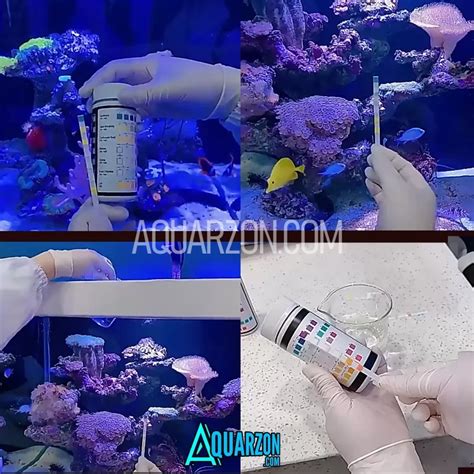Introduction
Aquarium water quality is a critical factor in maintaining the health and well-being of aquatic life. Proper water testing is essential for monitoring and adjusting water parameters to ensure optimal conditions. This article explores the importance of aquarium water testing, discusses various testing methods, and provides insights into the latest research on water quality management.

Importance of Aquarium Water Testing
Maintaining optimal water quality is crucial for several reasons:
- Healthy Environment: Stable water parameters provide a healthy and stress-free environment for aquatic organisms, reducing the risk of disease and improving overall well-being.
- Disease Prevention: Imbalances in water chemistry, such as excessive ammonia or pH deviations, can lead to physiological stress and increase susceptibility to infections.
- Water Quality Standards: Different species have specific water quality requirements. Testing ensures compliance with these standards, providing optimal conditions for each inhabitant.
- Environmental Monitoring: Monitoring water quality levels helps detect potential problems, such as leaks or chemical spills, allowing for prompt intervention.
Aquarium Water Testing Methods
A variety of aquarium water testing methods are available, including:
Liquid Test Kits
- Pros: Inexpensive, easy to use, and provide immediate results.
- Cons: Limited accuracy and can be subjective to user interpretation.
Test Strips
- Pros: Convenient, quick, and inexpensive.
- Cons: Less accurate than liquid test kits and may not detect certain parameters.
Electronic Meters
- Pros: Highly accurate and precise, providing reliable measurements.
- Cons: More expensive than other methods and require calibration.
Continuous Monitoring Systems
- Pros: Provide real-time monitoring of water parameters, offering early detection of problems.
- Cons: Often expensive and may require specialized expertise for interpretation.
Aquarium Water Quality Research
Research and advancements in aquarium water quality management continue to evolve:
Water Filtration Systems
Research: Novel filtration technologies are being developed to improve water clarity and remove contaminants, such as nanofiltration and ozone treatment.
Benefits: Enhanced water quality, reduced maintenance, and improved overall health of aquatic organisms.
Nitrogen Cycle Optimization
Research: Researchers are exploring methods to optimize the nitrogen cycle in aquariums, reducing the accumulation of harmful nitrogen compounds.
Benefits: Improved water quality, reduced algae growth, and healthier fish.
Water Chemistry Modeling
Research: Computational modeling is being used to simulate water chemistry and predict the effects of different scenarios on water quality.
Benefits: Improved understanding of water chemistry dynamics, allowing for more precise water management and problem-solving.
Bioremediation Techniques
Research: New bioremediation techniques are being investigated to harness the power of microorganisms to remove contaminants and improve water quality.
Benefits: Environmentally friendly, cost-effective, and sustainable approaches to water quality management.
Tips and Tricks for Aquarium Water Testing
- Test water regularly, especially after water changes or adding new organisms.
- Use calibrated equipment and follow manufacturer instructions carefully.
- Interpret results accurately and adjust water parameters gradually as needed.
- Consider purchasing a continuous monitoring system for real-time water quality data.
- Consult with experienced aquarists or water quality professionals for advice and guidance.
FAQs
Q: How often should I test my aquarium water?
A: The frequency depends on the stability of your aquarium and the number of occupants. Test at least monthly, and more often if there are changes or problems.
Q: What are the key water parameters to monitor?
A: Ammonia, nitrite, nitrate, pH, alkalinity, and hardness.
Q: What should I do if my test results show elevated levels of harmful substances?
A: Perform a partial water change and identify the source of the contamination. Adjust water parameters gradually and monitor the situation.
Q: Can I use tap water for my aquarium?
A: Tap water may contain chlorine or chloramine, which can harm aquatic life. Use a dechlorinator or allow the water to sit for 24 hours before adding it to the aquarium.
Q: How can I improve water quality in my aquarium?
A: Use a reliable filtration system, perform regular water changes, and maintain a stable water temperature and pH. Consider adding live plants, which can help absorb excess nutrients and improve water quality.
Market Insights
The aquarium water testing and quality management market is projected to experience significant growth by 2025. Factors driving this growth include:
- Increasing demand for home aquariums as a hobby
- Rising awareness of the importance of water quality
- Advancements in water testing technology
- Growing adoption of continuous monitoring systems
Case Detail
Case Study: Comparison of Water Quality in Two Aquariums
Aquarium A: Used a basic filtration system and performed monthly water tests.
Aquarium B: Utilized an advanced filtration system with real-time water monitoring.
Results: Aquarium B consistently maintained stable water parameters with lower levels of harmful substances. Fish in Aquarium B exhibited better health and fewer incidences of disease.
Conclusion
Aquarium water testing is a crucial aspect of aquarium maintenance, ensuring optimal conditions for aquatic life. The latest research and advancements in water quality management provide innovative solutions for monitoring and improving water chemistry. By understanding the importance of water testing, utilizing appropriate testing methods, and applying research-based approaches, aquarists can create a healthy and thriving aquatic environment.





















